Showing Spotlights 353 - 360 of 556 in category All (newest first):
 Silica nanomaterials have shown great promise for delivering anticancer and other water-insoluble drugs into human cancer cells. The high surface area, tunable pore diameter, and uniform mesoporous structure of the mesoporous silicas offer a unique advantage for loading and releasing large quantities of biomedical agents. These properties are beneficial for designing stimuli-response drug release and allow mesoporous silica nanoparticles (MSN) to be loaded with a drug. Especially MSNs with hollow and rattle structure show particularly higher drug loading efficiency because the interstitial hollow space can selectively and efficiently accommodate drug molecules. In what represents a significant progress of in vivo cancer therapy with mesoporous silica nanomaterials, researchers have demonstrated that silica nanorattles show advantages for in vivo enhancement of therapy efficacy and reducing the systematic toxicity of antitumor drugs.
Silica nanomaterials have shown great promise for delivering anticancer and other water-insoluble drugs into human cancer cells. The high surface area, tunable pore diameter, and uniform mesoporous structure of the mesoporous silicas offer a unique advantage for loading and releasing large quantities of biomedical agents. These properties are beneficial for designing stimuli-response drug release and allow mesoporous silica nanoparticles (MSN) to be loaded with a drug. Especially MSNs with hollow and rattle structure show particularly higher drug loading efficiency because the interstitial hollow space can selectively and efficiently accommodate drug molecules. In what represents a significant progress of in vivo cancer therapy with mesoporous silica nanomaterials, researchers have demonstrated that silica nanorattles show advantages for in vivo enhancement of therapy efficacy and reducing the systematic toxicity of antitumor drugs.
Dec 7th, 2010
 Scientists have shown that two pH response moieties - a pH solubility switch and a pH labile group - can be incorporated into the backbone of polymers which can then be formulated into dual responsive nanoparticles encapsulating small hydrophobic molecules and larger protein payloads. As nanoparticles they function akin to an AND logic gate. The beta-aminoester backbone moiety provides a pH triggered solubility switch, only when this switch is 'ON' does the ketal moiety also turn 'ON' to undergo rapid acid catalyzed hydrolysis. This system seems to be a promising vehicle for the administration of hydrophilic and hydrophobic payloads into target areas of the human body.
Scientists have shown that two pH response moieties - a pH solubility switch and a pH labile group - can be incorporated into the backbone of polymers which can then be formulated into dual responsive nanoparticles encapsulating small hydrophobic molecules and larger protein payloads. As nanoparticles they function akin to an AND logic gate. The beta-aminoester backbone moiety provides a pH triggered solubility switch, only when this switch is 'ON' does the ketal moiety also turn 'ON' to undergo rapid acid catalyzed hydrolysis. This system seems to be a promising vehicle for the administration of hydrophilic and hydrophobic payloads into target areas of the human body.
Nov 24th, 2010
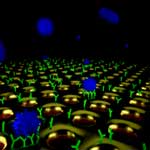 A multi-disciplinary research team has introduced a novel label-free optofluidic-nanoplasmonic biosensor and demonstrated direct detection of live viruses from biological media at medically relevant concentrations with little to no sample preparation. This novel platform can be easily adapted for point-of-care diagnostics to detect a broad range of viral pathogens in resource-limited clinical settings at the far corners of the world, in defense and homeland security applications as well as in civilian settings such as airports or other public spaces. This work is the first demonstration of detection of intact viruses using extraordinary light transmission phenomena in plasmonic nanohole arrays.
A multi-disciplinary research team has introduced a novel label-free optofluidic-nanoplasmonic biosensor and demonstrated direct detection of live viruses from biological media at medically relevant concentrations with little to no sample preparation. This novel platform can be easily adapted for point-of-care diagnostics to detect a broad range of viral pathogens in resource-limited clinical settings at the far corners of the world, in defense and homeland security applications as well as in civilian settings such as airports or other public spaces. This work is the first demonstration of detection of intact viruses using extraordinary light transmission phenomena in plasmonic nanohole arrays.
Nov 17th, 2010
 Medical researchers believe that the best way to protect eye from glaucoma is to protect the optic nerve from a sudden increase in intraocular pressure since ocular hypertension is the most important risk factor for glaucoma. Accordingly, for the past few years, huge research efforts have been made to develop a powerful biotechnical approach to protect the optic nerve. As a result, scientists discovered that Heat Shock Proteins (HSPs) can be a new powerful modality for the protection of optic nerves - ocular neuroprotection - from glaucoma. Although a variety of methods to induce HSPs have been developed and tried, they all were found to be ineffective for the induction of HSPs from the optic nerve due to side effects including chemical and physical side effects. A novel nanomedicine modality has now been shown to be feasible for ocular neuroprotection in glaucoma cases.
Medical researchers believe that the best way to protect eye from glaucoma is to protect the optic nerve from a sudden increase in intraocular pressure since ocular hypertension is the most important risk factor for glaucoma. Accordingly, for the past few years, huge research efforts have been made to develop a powerful biotechnical approach to protect the optic nerve. As a result, scientists discovered that Heat Shock Proteins (HSPs) can be a new powerful modality for the protection of optic nerves - ocular neuroprotection - from glaucoma. Although a variety of methods to induce HSPs have been developed and tried, they all were found to be ineffective for the induction of HSPs from the optic nerve due to side effects including chemical and physical side effects. A novel nanomedicine modality has now been shown to be feasible for ocular neuroprotection in glaucoma cases.
Oct 25th, 2010
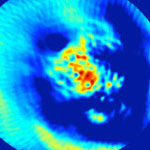 Gold-based nanostructures and carbon nanotubes have been successfully applied for photoacoustic imaging and photothermal treatment of tumors. Medical researchers believe that such nanoparticle-mediated, image-guided cancer therapy has tremendous promise for increasing the efficacy of cancer treatment while reducing toxic side effects traditionally associated with treatment. Working with a different carbon nanomaterial, researchers now have been able to show that polyhydroxy fullerenes can be utilized for the same purposes. The minute size and biocompatibility of polyhydroxy fullerenes make them particularly attractive for biomedical applications - they are water-soluble, biodegradable, antioxidant, and rapidly excreted.
Gold-based nanostructures and carbon nanotubes have been successfully applied for photoacoustic imaging and photothermal treatment of tumors. Medical researchers believe that such nanoparticle-mediated, image-guided cancer therapy has tremendous promise for increasing the efficacy of cancer treatment while reducing toxic side effects traditionally associated with treatment. Working with a different carbon nanomaterial, researchers now have been able to show that polyhydroxy fullerenes can be utilized for the same purposes. The minute size and biocompatibility of polyhydroxy fullerenes make them particularly attractive for biomedical applications - they are water-soluble, biodegradable, antioxidant, and rapidly excreted.
Sep 29th, 2010
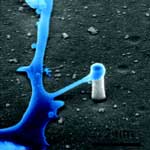 Studies of the interface between nanostructures and live cells have been increasing rapidly in the past few years. Because the size of nanostructures is often comparable to internal organelles inside the cell, those nanostructures are very useful in serving as sensors to detect biological events inside a live cell. For neuroscientists, monitoring the electrical signaling within neural networks is a fundamental issue. It has proven to be very challenging to monitoring individual neuron activities in a neuronal network for an extended time, which demands stable and specific neuron-electrode correspondence. Unfortunately for the scientists, neurons tend to migrate as far as hundreds of micrometers. With a new techniques, researchers have managed to engineer unique nanostructures that foster, rather than impose, residence of neuron cell bodies atop the electrode of interest.
Studies of the interface between nanostructures and live cells have been increasing rapidly in the past few years. Because the size of nanostructures is often comparable to internal organelles inside the cell, those nanostructures are very useful in serving as sensors to detect biological events inside a live cell. For neuroscientists, monitoring the electrical signaling within neural networks is a fundamental issue. It has proven to be very challenging to monitoring individual neuron activities in a neuronal network for an extended time, which demands stable and specific neuron-electrode correspondence. Unfortunately for the scientists, neurons tend to migrate as far as hundreds of micrometers. With a new techniques, researchers have managed to engineer unique nanostructures that foster, rather than impose, residence of neuron cell bodies atop the electrode of interest.
Sep 16th, 2010
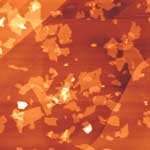 Current protein detection approaches are mainly dominated by heterogeneous immunological (or separation) assay methods. These assays are usually low-throughput and frequently require multiple steps including multiple incubation and careful washing of a surface onto which the labeled reagent has bound. In contrast, homogenous immunoassays can overcome these problems. In these assays, the signal is affected by binding and can often be run without a separation step. Such assays can frequently be carried out simply by mixing the reagents and sample and making a physical measurement. Researchers in China and Japan have now developed a graphene oxide based fluorescence assay for fast, ultra-sensitive, and selective detection of protein and demonstrated its use for detection of a prognostic indicator in early-stage cancer, cyclin A2.
Current protein detection approaches are mainly dominated by heterogeneous immunological (or separation) assay methods. These assays are usually low-throughput and frequently require multiple steps including multiple incubation and careful washing of a surface onto which the labeled reagent has bound. In contrast, homogenous immunoassays can overcome these problems. In these assays, the signal is affected by binding and can often be run without a separation step. Such assays can frequently be carried out simply by mixing the reagents and sample and making a physical measurement. Researchers in China and Japan have now developed a graphene oxide based fluorescence assay for fast, ultra-sensitive, and selective detection of protein and demonstrated its use for detection of a prognostic indicator in early-stage cancer, cyclin A2.
Sep 13th, 2010
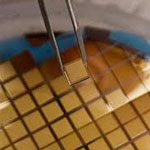 Australian researchers have introduced the Nanopatch - a new way of delivering vaccines to the skin and potentially a safer, cheaper alternative to traditional needle vaccines. The Nanopatch comprises arrays of densely packed projections with a defined geometry and distribution designed to physically target vaccines directly to thousands of epidermal and dermal antigen presenting cells. These miniaturized arrays are two orders of magnitude smaller than standard needles and are also much smaller than current microneedle arrays. The core idea is to achieve improved vaccine efficiency and effectiveness - over the needle and syringe - through precise targeting of vaccines to skin strata, achieved by device miniaturization utilizing micro- and nanotechnologies.
Australian researchers have introduced the Nanopatch - a new way of delivering vaccines to the skin and potentially a safer, cheaper alternative to traditional needle vaccines. The Nanopatch comprises arrays of densely packed projections with a defined geometry and distribution designed to physically target vaccines directly to thousands of epidermal and dermal antigen presenting cells. These miniaturized arrays are two orders of magnitude smaller than standard needles and are also much smaller than current microneedle arrays. The core idea is to achieve improved vaccine efficiency and effectiveness - over the needle and syringe - through precise targeting of vaccines to skin strata, achieved by device miniaturization utilizing micro- and nanotechnologies.
Aug 31st, 2010
 Silica nanomaterials have shown great promise for delivering anticancer and other water-insoluble drugs into human cancer cells. The high surface area, tunable pore diameter, and uniform mesoporous structure of the mesoporous silicas offer a unique advantage for loading and releasing large quantities of biomedical agents. These properties are beneficial for designing stimuli-response drug release and allow mesoporous silica nanoparticles (MSN) to be loaded with a drug. Especially MSNs with hollow and rattle structure show particularly higher drug loading efficiency because the interstitial hollow space can selectively and efficiently accommodate drug molecules. In what represents a significant progress of in vivo cancer therapy with mesoporous silica nanomaterials, researchers have demonstrated that silica nanorattles show advantages for in vivo enhancement of therapy efficacy and reducing the systematic toxicity of antitumor drugs.
Silica nanomaterials have shown great promise for delivering anticancer and other water-insoluble drugs into human cancer cells. The high surface area, tunable pore diameter, and uniform mesoporous structure of the mesoporous silicas offer a unique advantage for loading and releasing large quantities of biomedical agents. These properties are beneficial for designing stimuli-response drug release and allow mesoporous silica nanoparticles (MSN) to be loaded with a drug. Especially MSNs with hollow and rattle structure show particularly higher drug loading efficiency because the interstitial hollow space can selectively and efficiently accommodate drug molecules. In what represents a significant progress of in vivo cancer therapy with mesoporous silica nanomaterials, researchers have demonstrated that silica nanorattles show advantages for in vivo enhancement of therapy efficacy and reducing the systematic toxicity of antitumor drugs. 
 Subscribe to our Nanotechnology Spotlight feed
Subscribe to our Nanotechnology Spotlight feed





